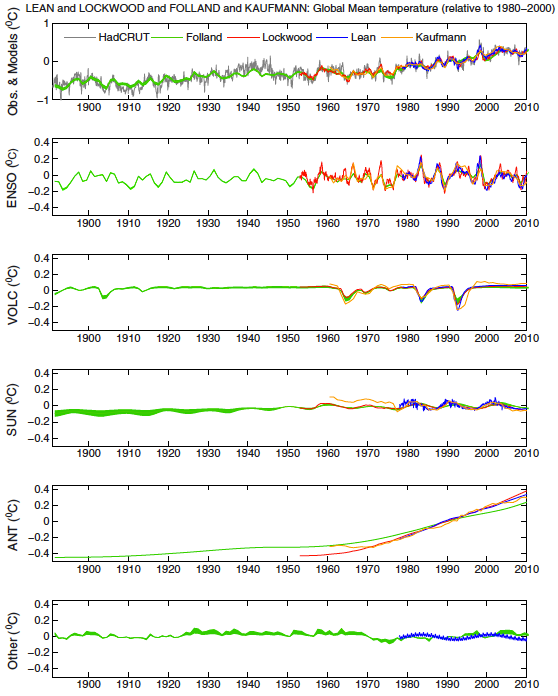
A new study published in the Journal of Geophysical Research – Atmospheres by Imbers, Lopez, Huntingford, and Allen tests the robustness of the detection of human-caused global warming in previous studies. Specifically their study builds on Lean and Rind (2009), Folland et al. (2013) (which they refer to as Folland 2011, based on an abstract presented at the AGU conference in 2011 of the recently-published 2013 paper), Kaufmann et al. (2011), and Lockwood (2008), as well as considering Loehle and Scafetta (2011).
Imbers et al. investigated whether using different characterizations and models of internal natural variability in the climate system (for example the El Niño Southern Oscillation [ENSO] and Atlantic Multidecadal Oscillation [AMO]), with both short and long memory processes, would impact the detection of the human-caused global warming signal. The results of the previous studies listed above are illustrated in Figure 1.
Figure 1: The top panel shows the observed global mean air surface temperature anomaly from HadCRUT3 (gray line) and the best multivariate fits using the methods of Lean and Rind [2009] (blue line), Lockwood [2008] (red line), Folland et al. [2011] (green line), and Kaufmann et al. [2011] (orange line). The remaining panels show the individual temperature contributions to the top panel fits from ENSO (second panel), volcanoes (third panel), solar irradiance (fourth panel), anthropogenic contribution (fifth panel), and other factors (sixth panel) that include the AMO for Folland et al. [2011] and minor annual, semi-annual, and 17.5 year cycle identified by Kopp and Lean [2011] in the residuals of Lean and Rind’s [2009] model.
The human contribution to global surface warming (the fifth panel in Figure 1) is shown in Figure 2. Click the image for a larger version.
Figure 2: The human (anthropogenic) contribution to global surface warming. From Imbers et al. (2013).
These studies estimate the human contribution to global surface warming over the past 30–60 years at approximately:
Note that the overall global surface warming trend over this timeframe is approximately 0.16–0.17°C per decade, meaning that these studies put the human contribution in the 70–100% range.
Imbers et al. found that all of the global surface temperature influences they examined (ENSO, AMO, solar, volcanic, and anthropogenic) were detectable in the data from all of these studies, with the possible exception of the solar influence in the Kaufmann study, whose range of possible temperature influences did overlap with zero.
Overall, regardless of their modeled characteristics of internal climate variability, Imbers et al. found a robust detection of the human-caused global surface warming signal.
They also tested what would happen when the temperature contribution of ENSO contribution is separated as a signal and removed from the data (dotted lines in Figure 3) vs. when it's included in the residual internal climate variability (solid lines in Figure 3). A lower value (scaling factor) means a smaller contribution from an influence on global surface temperature. For example, the volcanic influence blue solid line is lower than the blue dotted line, indicating that when ENSO is treated as a part of residual internal climate variability, it suggests a smaller volcanic temperature influence.
Figure 3: Scaling factors and their 95% confidence interval (vertical axis) for the different signals: ENSO, volcanic (VOL), solar (SOL), anthropogenic (ANT), and AMO (as indicated in the horizontal axis); using the data from the four studies: Lean (blue), Lockwood (red), Folland (green), and Kaufmann (orange). Illustrating the sensitivity of the detection statistics to ENSO, when its contribution to the global mean temperature is separated as a signal (dotted lines) or included in the residual internal variability (thick lines).
As you can see, the treatment of ENSO does not make a significant difference in the detection of the human-caused global warming signal. It's the non-anthropogenic signals where the treatment of ENSO makes a difference in their contributions to global surface warming.
Imbers et al. also considered the 20-year and 60-year cycles proposed by Loehle and Scafetta. Once again, they found that including these cycles did not make a significant difference in the detection of the human-caused global warming signal. The biggest difference was in the temperature contribution of AMO. However, Imbers et al. found that overall the cycles proposed by Loehle and Scafetta were insignificant contributors to global surface temperature changes.
"The results of this statistical study suggest that adding these two low-frequency [20- and 60-year] oscillations does not change significantly the detection and attribution of the anthropogenic signal in any of the studies considered ... These results suggest that statistically these cycles are not significant and are not clearly distinguishable from the internal variability as described by our noise models."
Ultimately Imbers et al. conclude,
"the detection of the anthropogenic signal is statistically robust independent of the model utilized to characterize the internal variability."
In other words, consistent with the 97% expert consensus, human-caused global warming is a reality, and humans are responsible for the majority of the global surface warming in recent decades.
Posted by dana1981 on Monday, 3 June, 2013
 |
The Skeptical Science website by Skeptical Science is licensed under a Creative Commons Attribution 3.0 Unported License. |